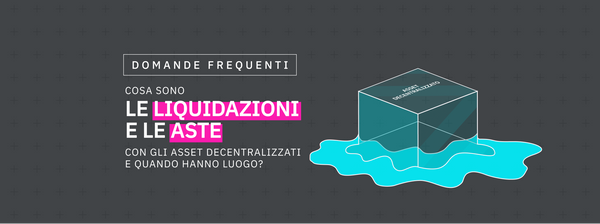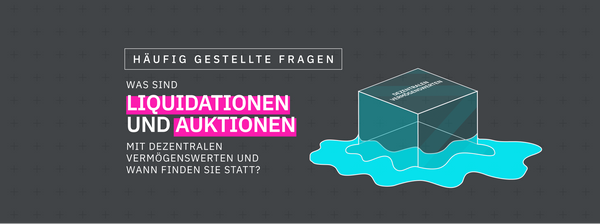An Intro Into The Foundational Concepts of Decentralized Loans on DeFiChain
Our much anticipated upgrade after Eunos Paya, which will be named Fort Canning, will not only bring decentralized loans to DeFiChain, but it will also facilitate the integration of many more products and services, offering a totally new playground for DeFiChain users.
Decentralized loans are without a doubt the most anticipated new implementation of the Fort Canning update. These loan mechanism have the potential to facilitate more than the conventional loans you may be familiar with. They will not only power loan issuance in US-Dollars (similar to how it would work with your local bank), but they will also form a key foundation layer in the DeFiChain decentralized tokenization of stocks.
In the following article, we take a closer look into the conceptualization of decentralized loans on DeFiChain. We will start by outlining the architectural foundation on the DeFiChain blockchain underpinning the entire construct, before diving deeper into each of the integral parts needed to build this interconnected loan ecosystem. In the second part of this series, we will provide a walkthrough of how decentralized loans will work on the DeFiChain DEX.

Architectural Foundations
In the course of introducing decentralized loans, DeFiChain is also rolling out the tokenization of stocks, commodities and precious metals. With initial plans to utilize Futures as a backbone to DeFiChain’s tokenization efforts, DeFiChain since eliminated that notion in favour of a more elegant and significantly more robust solution. As a result, all stocks, commodities and precious metals that can be traded on DeFiChain will be powered by decentralized loans.
The foundation on which decentralized loans will be based is an interconnected spider web — an ecosystem between oracles, DeFiChain’s DEX and newly introduced operators and vaults. All these integral parts together will power stock trading in the DeFi space, in the most decentralised manner. Figure 1 gives you an overview of how this ecosystem works.
Operators
An operator can be compared to establishing your own bank directly on the DeFiChain blockchain. By setting up an operator, you are able to set parameters such as the collateralization ratio, the interest rate and the liquidation penalty for all actions undertaken within your “bank” or operator space. Whenever someone wants to take out a loan or puts funds into a vault, then this person is required to abide by the rules that you have set.
By introducing operators, DeFiChain wants to clearly separate the role of the blockchain from the operator — the party in charge of offering financial products. The generalization goals are to allow anyone to create and run as an operator on DeFiChain, without requiring any prior permissions from the DeFiChain Foundation or its developers.
Each operator operates in its very own space — called the Opspace. Each Opspace is unique and does not interfere with the operations of other Opspaces, nor the blockchain ecosystem.
With the introduction of operators, all current DeFiChain Asset Tokens (DAT) — basically all tokens that can be traded on the DEX — will be migrated over to the first Opspace as soon as the functionality becomes available. At roll-out, there will be a single default Opspace available, which will be set up by DeFiChain on behalf of the community. Decentralized stock trading via loans will be able to take place in this Opspace. In a second step, it will also be possible for community members to create an Opspace by paying a 1,000 DFI fee, which will get burned.
Oracles
An oracle is a data source used to bridge a smart contract to an external source. As such, it not only communicates with external data sources, but it also verifies and authenticates that the data provided is accurate.
At DeFiChain these oracles are appointed by operators and each operator can appoint multiple oracles for the same price feed. The oracles will primarily focus on providing accurate price feeds from outside the DeFiChain ecosystem and will be rolled out with the Eunos Paya upgrade.
Oracles on DeFiChain are set up through a serverless architecture and linked up with various providers via a SaaS solution. One of the most well known stock exchanges and platform providers in the world, will also be providing price feeds for DeFiChain’s decentralized stock trading.
The DFI price feeds, however, will be taken from various exchanges DFI is listed on and also from DeFiChain’s own DEX in the form of DFI-BTC. From a technical perspective, the latter price feed is fed back externally via a serverless service provider to minimize failures and manipulations.

Most importantly, though, oracles are not used to determine the price of the tokens that are traded on DeFiChain, It’s only used for liquidation purposes of undercollateralized loans. As a result, the price i.e. Tesla trades on DeFiChain’s DEX is independently set by demand and supply and is not influenced or set by an oracle price. It’s very similar to the current liquidity mining pools, where the price is also set by market forces in the form of arbitrageurs.
Vaults
A vault is similar to having an account at a bank. It operates within the Opspace and can be set up by anyone for free. The owner of a vault can deposit collateral and take out a loan against it. Each vault that is operating in the same Opspace has to follow the same rules set by the operator.
Taking out a loan against your crypto holding has to go through a vault. The user has to first open a vault, transfer in collateral in the form of DFI, BTC or USDC to be able to fund a loan and mint (loan) tokens. The total sum transferred into your vault is your collateral. This collateral has to be at least 50% in DFI; the rest can be BTC, ETH or USDC, in any ratio.
By allowing just the most stable cryptocurrencies to act as collateral, ensures that the vaults are less exposed to volatility and that DFI plays a prominent role in the whole concept of decentralized loans and tokenization.
Collateralization Ratio
Loan on DeFiChain operates on an over-collateralization mechanism, where the users have to first open a vault to mint tokens. The collateralization is calculated for each single vault by using the following formula:
Collateralization ratio = Total effective value of collateral / (Total value of tokens minted + Total interest)
For example, if a vault holds $2,000 worth of collateral assets, with $900 minted tokens and $100 of total interest accrued, then the collateralization ratio is 2,000 / (900 + 100) = 2.
The collateralization ratio is not the same as the collateralization factor, which will be discussed below.
Collateralization factor
An operator can decide which assets are accepted for collateralization and also place a different weighting factor — also known as collateralization factors — on these assets. The collateralization factor can vary from 0% to 100% and depends on the volatility of the asset. When an asset collateralization factor is 100%, the entirety of the asset's value contributes to the collateralization value of the vault, however, if an asset collateralization factor is just 50%, then only half of its value contributes to the total vault's collateral.
For example, if DOGE is accepted by the Opspace and has a 70% collateralization factor, then $100 of DOGE would contribute to $70 of collateral value to a vault.
Summary
Decentralized loans will form the backbone of the tokenization of stocks, commodities and precious metals on DeFiChain. The foundation on which decentralized loans are based is an interconnected spider web, an ecosystem between oracles, DeFiChain’s DEX, and to be introduced operators and vaults.
In this article we look into the foundational concepts of decentralized loans on DeFiChain. In the next article of this series, we will take a closer look into the real world applications of DeFiChain’s loan function.
It will be a journey through already established concepts adapted and improved for DeFiChain’s purpose. True decentralization in stock trading is on the horizon and #nativeDeFi on DeFiChain will soon be the gold standard for any DeFi project out there.
If you are interested in the project and would like to keep up with the latest news and updates on DeFiChain, then join the official Reddit, Telegram and Twitter channels.





